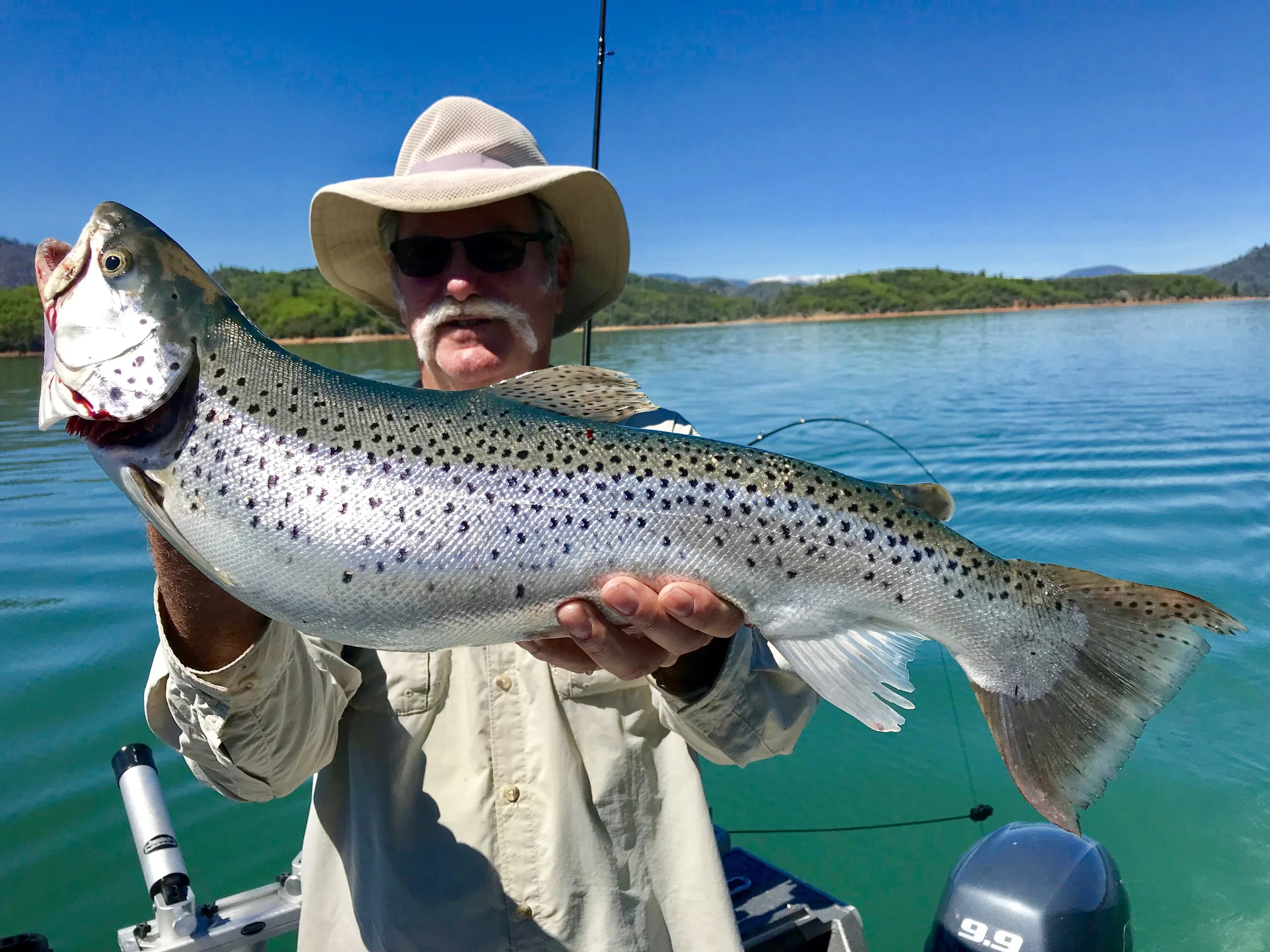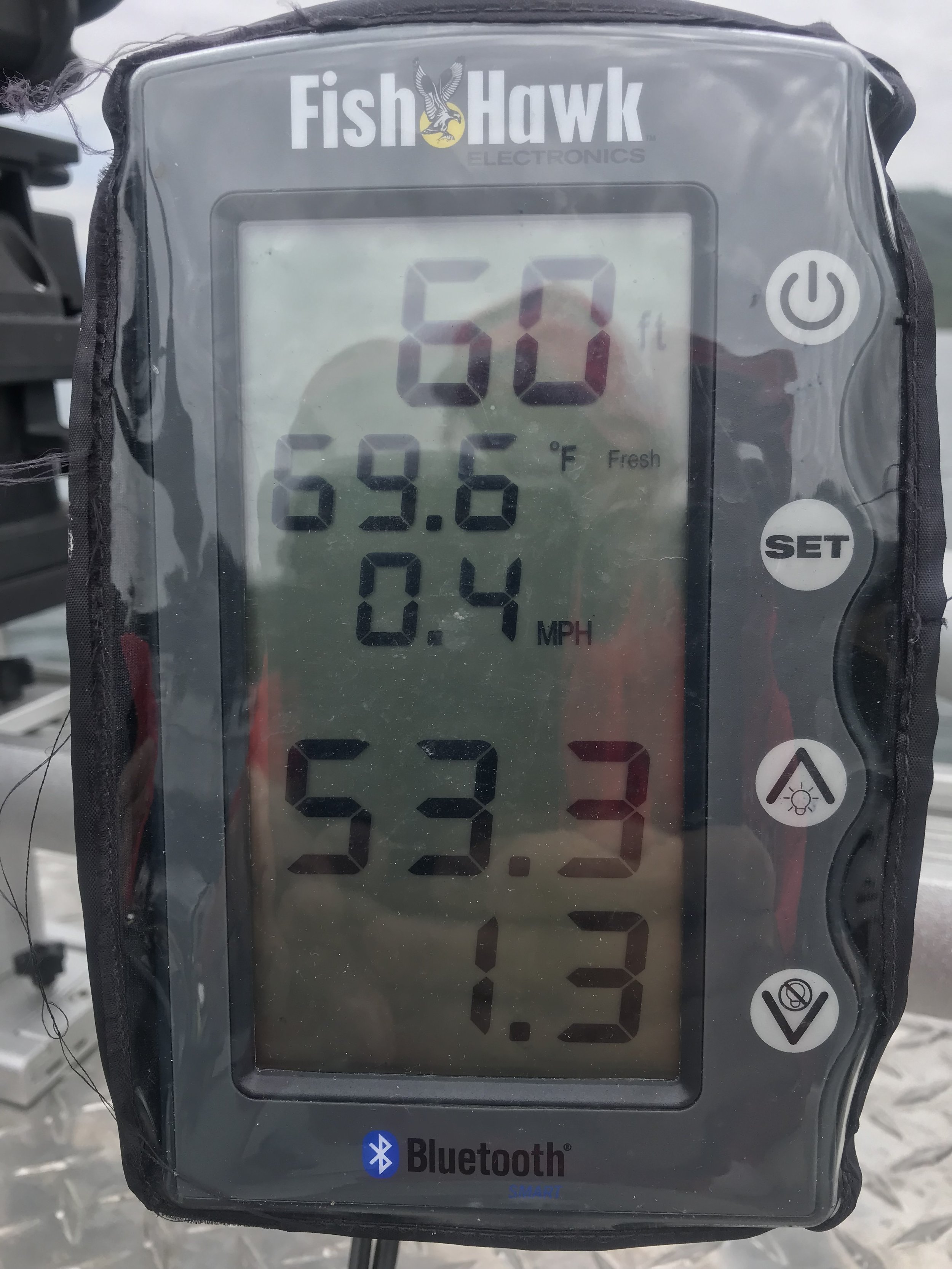Shasta Lake spring brown trout!
Shasta Lake spring trout fishing.
The spring brown trout fishing is in full swing on Shasta Lake. The lake is in its spring transition and teeming with life after a long hard winter. The Carpenter ant hatch is going, the Plankton blooms are huge, and the Shad are starting the migration down into the main body of Shasta Lake where they will soon be spawning. This is a magical time on the lake with amazing weather and a shot at some of the years biggest brown trout anglers will catch all year. It seems like the longest winter ever, but its over now and time to go trophy hunting.
Trout trolling depths for Shasta Lake.
With weather already exceeding 90 degrees this past week, we’ve seen the surface temps rise from a cool 48 degrees up to a really warm 71 degrees. Today is another day of hot weather so I only anticipate the surface temps will continue to rise. Most years the lake surface will reach 80 plus degrees before it starts to build a thicker and thicker layer of warm water near the surface. As this warm water developed, so does the thermocline (where mark water meets cold water). This is an important progression for the lake, but also for the anglers who fish for trout.
Trolling in or above the thermocline is important because most often, the fish that are actively seeking food or will be the biters. I have a few tools which help me find the best water temps to place my gear in, maximizing my time in the strike zone. First is a useful tool called the Fish Hawk X4D. Its an attached device I send down into the water along with my downrigger ball. It has the ability to determine, depth at the ball, temp at the ball, and speed at the ball. Depth and temperature are what I may attention to the most. I can clearly see where the temperature changes and at what depth, exactly. This helps me zero in on the most productive water temperatures to catch trout. You can also see the thermocline on sonar and will display as a clutter line at the depth the thermocline exists. In the warmer months, bite patterns show that the low 60’s is a good place to start trolling your gear.
This is a good temperature range because its just below the water that the Shad will be holding in and also below the bass that will start to suspend below the Shad balls. If you are trolling and catching lots of bass, drop your lines down. The trout will often times be holding in cooler water below the bass and Shad. This pattern holds throughout the summer and all you have to do to find trout in Shasta Lake is to keep your gear near the thermocline. It starts around 20-30’ most years and will be in excess of 100’ feet by early fall.
The Fish Hawk X4D keeps my gear in the strike zone every day!
Trolling gear for Shasta Lake trout.
Some of the most effective presentations for Shasta Lake in the spring are often going to match the main food source for fish in Shasta Lake, and thats Threadfin Shad. Small spoons, stick baits, squid skirts, or even brined Shad bait can be used for trolling for trout in Shasta Lake and is a very effective way to catch them. Any of these lures or baits behind a small dodger can be deadly, and will attract a lot of strikes. A small 6” Trinidad Tackle dodger in front of any of these baits is a great option as well!
Trout this time of the year can be found above 20’ feet, but soon they will be much deeper, near colder water. I tell my clients that the trout will live in their comfort zone, but will move out of that area to find food. Their food source isn’t often found in the cooler water temps, its up above them in warmer water. Thats why I start trolling in the low 60’s. Its a good median temperature thats above holding trout but close to where the Shad will be holding in the high 60 degree water.
The key to keeping your gear in the strike zone is to have some sort of system to get your gear down to where the fish are. People often wonder why fishing is so hard for them in the summer when the water is warm. Its because the fish aren’t up in the really warm water, they are down where the cold water is. There are many ways to get your gear down to the fish these days, but I would say downriggers are by far the most commonly used tool for the job.
My Cannon Digi-Troll 10’s are amazing, but any downrigger, manual or electric will get the job done.
Trolling speeds and locations.
Now that your all set with finding the right depth and armed with all the right gear, its important to know what your trolling speed should be and where you should be trolling. I tell my clients that trolling speeds can range from 1.5 mph to 4.0 mph, but the gear you have on every line must have the capability to present properly at any given speed. For example, if you are running big Optimizer spoons at 3.8 mph, you don’t want to have a line out with a 6” dodger attached. The dodger just won’t present properly at that speed and will be a useless line in the water. The same goes for the Optimizer spoon being trolled at 1.7 mph where the dodger will shine. they just don’t go together and shouldn’t be trolled at the same speed. Check your lures next to the boat to see how they are working before letting lines out, its critical. If your fishing 4 line, fish them with gear that will run right at your chosen trolling speed. if I’m running big spoons, I will often times run all my rods with those spoons. if I’m running with dodgers, all the lines will have dodgers. I find that the one exception is the Bay Rat Lures I use every day. They, like a lot of stick baits will run in a wide speed range. Trolled fast or slow, they will catch fish.
So now that we are running our gear properly, and at the right depth, where should we be trolling? Well, right now you can find trout at the tops of the arms all the way to Shasta Dam. As summer arrives and as the thermocline develops, most of the trout will be down in the main body of the lake or low in the arms where all the Shad are. Early on, before and after they spawn, the Shad will be cruising the shorelines of the main lake, but as the warm water layer developed, they will push out over open (deep) water where they will suspend and sit in their comfort zone where they will feed on Plankton. Anyone with a fish finder/sonar unit will be able to locate them. The Shad balls are obvious and you’ll be marking larger game fish around them. This make it easy to find the trout and tells you where you should be fishing.
Shasta Lake is a big body of water, but it gets really small in the summer and its easy to find the trout. Just follow the principles I put out for you and build on them to be a successful trout fisherman on this amazing fishery!
Bait balls and big fish marks help you zero in on the trout in Shasta Lake.






